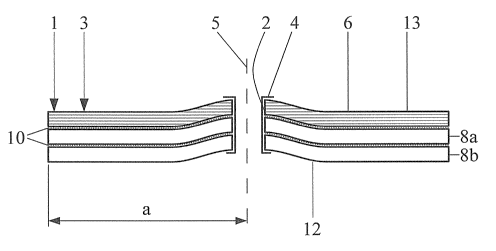Some of the information on this Web page has been provided by external sources. The Government of Canada is not responsible for the accuracy, reliability or currency of the information supplied by external sources. Users wishing to rely upon this information should consult directly with the source of the information. Content provided by external sources is not subject to official languages, privacy and accessibility requirements.
Any discrepancies in the text and image of the Claims and Abstract are due to differing posting times. Text of the Claims and Abstract are posted:
| (12) Patent Application: | (11) CA 3033406 |
|---|---|
| (54) English Title: | ROUGHING DISC HAVING A BACKING LAYER |
| (54) French Title: | MEULE DE DEGROSSISSAGE COMPRENANT UNE COUCHE DE SUPPORT |
| Status: | Report sent |
| (51) International Patent Classification (IPC): |
|
|---|---|
| (72) Inventors : |
|
| (73) Owners : |
|
| (71) Applicants : |
|
| (74) Agent: | NORTON ROSE FULBRIGHT CANADA LLP/S.E.N.C.R.L., S.R.L. |
| (74) Associate agent: | |
| (45) Issued: | |
| (86) PCT Filing Date: | 2017-05-31 |
| (87) Open to Public Inspection: | 2018-02-15 |
| Examination requested: | 2022-05-30 |
| Availability of licence: | N/A |
| (25) Language of filing: | English |
| Patent Cooperation Treaty (PCT): | Yes |
|---|---|
| (86) PCT Filing Number: | PCT/EP2017/063090 |
| (87) International Publication Number: | WO2018/028849 |
| (85) National Entry: | 2019-02-08 |
| (30) Application Priority Data: | ||||||
|---|---|---|---|---|---|---|
|
The invention relates to a roughing disc for machining material surfaces, comprising a disc-shaped main body having a tool side, which can face a tool, and a workpiece side, which can face a workpiece, the main body comprising a central opening through which an axis of rotation passes and which serves for direct or indirect attachment of a drive shaft of the tool, a disc-shaped backing layer disposed on the tool side, at least one abrasive layer, and a separating layer between adjacent layers. The backing layer is made of a material mixture that is free of abrasive additives and that comprises at least one mineral additive.
L'invention concerne une meule de dégrossissage pour l'usinage de surfaces de matériau. La meule de dégrossissage comprend un corps de base en forme de disque pourvue d'une face outil pouvant être tournée vers un outil et d'une face pièce pouvant être tournée vers une pièce. Le corps de base comporte un évidement central traversé par un axe de rotation pour le raccordement direct ou indirect d'un arbre d'entraînement de l'outil, une couche de support en forme de disque agencée sur le côté outil, au moins une couche de dégrossissage et une couche de séparation entre les couches voisines. La couche de support est formée d'un mélange de matériau, lequel est exempt d'additifs abrasifs et lequel comporte au moins un additif minéral.
Note: Claims are shown in the official language in which they were submitted.
Note: Descriptions are shown in the official language in which they were submitted.

For a clearer understanding of the status of the application/patent presented on this page, the site Disclaimer , as well as the definitions for Patent , Administrative Status , Maintenance Fee and Payment History should be consulted.
| Title | Date |
|---|---|
| Forecasted Issue Date | Unavailable |
| (86) PCT Filing Date | 2017-05-31 |
| (87) PCT Publication Date | 2018-02-15 |
| (85) National Entry | 2019-02-08 |
| Examination Requested | 2022-05-30 |
| Abandonment Date | Reason | Reinstatement Date |
|---|---|---|
| 2023-11-30 | FAILURE TO PAY APPLICATION MAINTENANCE FEE |
Last Payment of $203.59 was received on 2022-04-26
Upcoming maintenance fee amounts
| Description | Date | Amount |
|---|---|---|
| Next Payment if small entity fee | 2023-05-31 | $100.00 |
| Next Payment if standard fee | 2023-05-31 | $277.00 |
Note : If the full payment has not been received on or before the date indicated, a further fee may be required which may be one of the following
Patent fees are adjusted on the 1st of January every year. The amounts above are the current amounts if received by December 31 of the current year.
Please refer to the CIPO
Patent Fees
web page to see all current fee amounts.
| Fee Type | Anniversary Year | Due Date | Amount Paid | Paid Date |
|---|---|---|---|---|
| Application Fee | $400.00 | 2019-02-08 | ||
| Maintenance Fee - Application - New Act | 2 | 2019-05-31 | $100.00 | 2019-02-08 |
| Maintenance Fee - Application - New Act | 3 | 2020-06-01 | $100.00 | 2020-04-20 |
| Maintenance Fee - Application - New Act | 4 | 2021-05-31 | $100.00 | 2021-04-23 |
| Maintenance Fee - Application - New Act | 5 | 2022-05-31 | $203.59 | 2022-04-26 |
| Request for Examination | 2022-05-31 | $814.37 | 2022-05-30 |
Note: Records showing the ownership history in alphabetical order.
| Current Owners on Record |
|---|
| KLINGSPOR AG |
| Past Owners on Record |
|---|
| None |